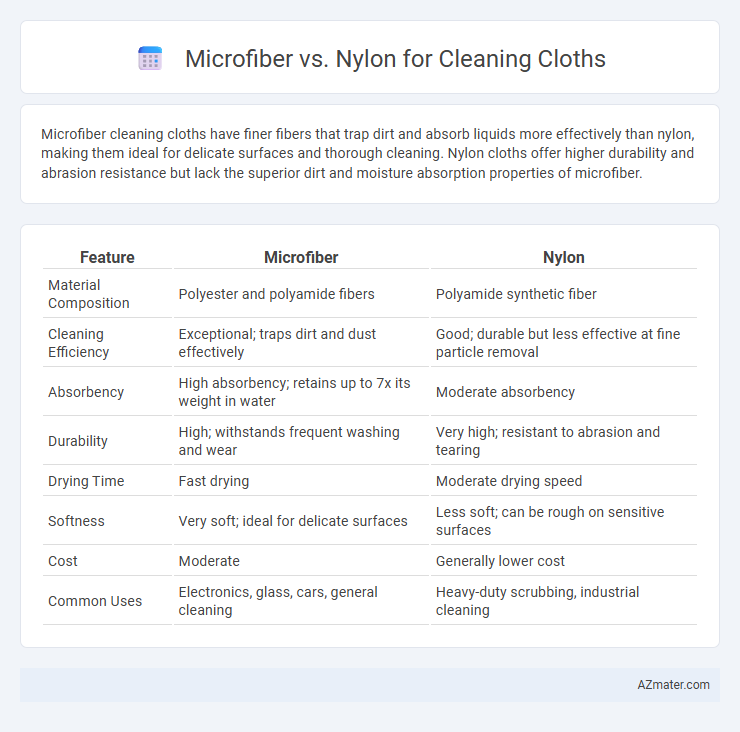Microfiber cleaning cloths have finer fibers that trap dirt and absorb liquids more effectively than nylon, making them ideal for delicate surfaces and thorough cleaning. Nylon cloths offer higher durability and abrasion resistance but lack the superior dirt and moisture absorption properties of microfiber.
Table of Comparison
| Feature | Microfiber | Nylon |
|---|---|---|
| Material Composition | Polyester and polyamide fibers | Polyamide synthetic fiber |
| Cleaning Efficiency | Exceptional; traps dirt and dust effectively | Good; durable but less effective at fine particle removal |
| Absorbency | High absorbency; retains up to 7x its weight in water | Moderate absorbency |
| Durability | High; withstands frequent washing and wear | Very high; resistant to abrasion and tearing |
| Drying Time | Fast drying | Moderate drying speed |
| Softness | Very soft; ideal for delicate surfaces | Less soft; can be rough on sensitive surfaces |
| Cost | Moderate | Generally lower cost |
| Common Uses | Electronics, glass, cars, general cleaning | Heavy-duty scrubbing, industrial cleaning |
Introduction to Microfiber and Nylon Cleaning Cloths
Microfiber cleaning cloths consist of ultra-fine synthetic fibers, typically polyester and polyamide, offering superior dirt and moisture absorption. Nylon cleaning cloths, made from strong synthetic polymers, provide durability and resistance to wear but often lack the fine texture that traps particles as effectively. Choosing between them depends on the required cleaning intensity, surface type, and moisture retention needs.
Material Composition: Microfiber vs Nylon
Microfiber cleaning cloths consist of ultra-fine synthetic fibers, typically a blend of polyester and polyamide, engineered to trap dirt, dust, and moisture efficiently due to their high surface area and electrostatic properties. Nylon cleaning cloths are made from polyamide polymers with larger fiber diameters, offering durability and abrasion resistance but less effective particle trapping compared to microfiber. The unique weave and fiber density in microfiber give it superior cleaning performance, while nylon excels in toughness and longevity for demanding cleaning tasks.
Absorbency and Cleaning Efficiency Comparison
Microfiber cloths exhibit superior absorbency with their ultra-fine fibers capable of retaining up to seven times their weight in liquid, making them ideal for efficient water and spill clean-up. Nylon cleaning cloths, while durable and quick-drying, have lower absorbency due to thicker fibers, resulting in less efficient liquid retention and spreading moisture rather than trapping it. Microfiber's structure allows for enhanced cleaning efficiency by trapping dirt, dust, and oils effectively without the need for harsh chemicals, whereas nylon cloths tend to require additional cleaning agents for optimal performance.
Durability and Longevity
Microfiber cleaning cloths offer superior durability due to their tightly woven synthetic fibers that resist tearing and maintain effectiveness after multiple washes. Nylon cloths, while strong and abrasion-resistant, tend to degrade faster with frequent exposure to harsh cleaning agents and high-temperature laundering. The longevity of microfiber outperforms nylon by retaining softness and cleaning efficiency over hundreds of uses, making it the preferred choice for long-term cleaning applications.
Suitability for Different Surfaces
Microfiber excels at cleaning delicate surfaces like glass, screens, and polished furniture due to its ultra-fine fibers that trap dust and oils without scratching. Nylon cloths are better suited for tougher, rougher surfaces such as countertops and outdoor equipment, offering greater durability and abrasion resistance. Choosing microfiber or nylon depends on the cleaning task's surface sensitivity and required thoroughness.
Environmental Impact and Sustainability
Microfiber cloths, made from synthetic fibers like polyester and polyamide, shed microplastics during washing, contributing to water pollution and posing challenges to marine life. Nylon, while also synthetic, tends to have a longer lifespan and better durability, reducing the frequency of replacement and waste generation. Choosing nylon cloths with recycled content or opting for biodegradable alternatives can significantly improve environmental sustainability in cleaning practices.
Cost Effectiveness and Value
Microfiber cleaning cloths offer superior cost effectiveness compared to nylon due to their enhanced durability and ability to trap dirt and bacteria more efficiently, reducing the need for frequent replacements. Although nylon cloths tend to be less expensive upfront, their lower absorbency and quicker wear can increase overall cleaning costs over time. Investing in high-quality microfiber delivers greater long-term value by minimizing cleaning time and maintenance expenses.
Maintenance and Care Requirements
Microfiber cloths require gentle washing with mild detergents and should be air-dried or tumble-dried on low heat to maintain their fiber structure and effectiveness. Nylon cleaning cloths are more durable under higher temperatures and can withstand stronger detergents but may lose softness over time with frequent washing. Regular maintenance of both materials involves avoiding fabric softeners and bleach to preserve absorbency and prolong the lifespan of the cleaning cloths.
Common Uses and Application Scenarios
Microfiber excels in cleaning tasks requiring high absorbency and fine dust removal, making it ideal for wiping glass, electronics, and delicate surfaces without scratching. Nylon cleaning cloths perform well in scrubbing tougher grime and grease on kitchen counters, pots, and outdoor equipment due to their durability and abrasion resistance. Choosing between microfiber and nylon depends on the specific cleaning scenario, with microfiber favored for precision cleaning and nylon preferred for heavy-duty scrubbing.
Choosing the Right Cleaning Cloth: Microfiber or Nylon
Microfiber cleaning cloths excel in trapping dust, dirt, and bacteria due to their ultra-fine synthetic fibers, making them ideal for delicate surfaces and electronics. Nylon cleaning cloths offer superior durability and abrasion resistance, suitable for heavy-duty scrubbing and rougher surfaces. Selecting the right cleaning cloth depends on the surface sensitivity and cleaning intensity, where microfiber is preferred for gentle, streak-free finishes and nylon for tougher grime and longer-lasting use.

Infographic: Microfiber vs Nylon for Cleaning Cloth
 azmater.com
azmater.com